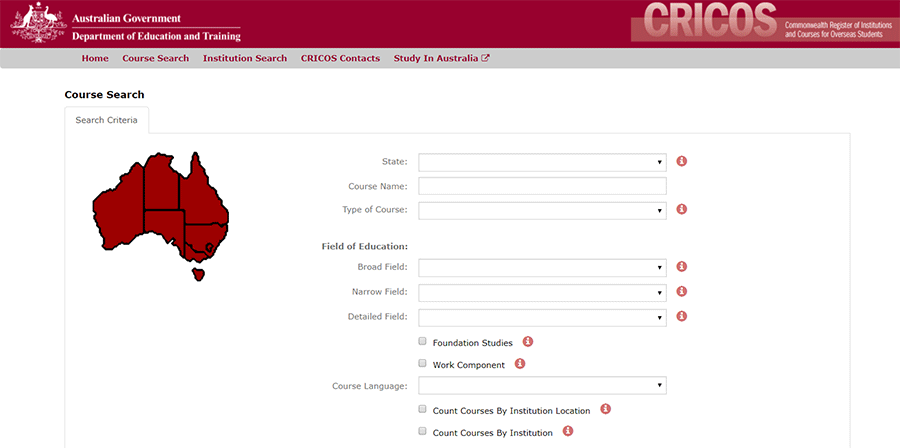The Commonwealth Register of Institutions and Courses for Overseas Students (CRICOS) is a crucial resource for international students looking to study in Australia. cricos Australia ensures that educational institutions and courses meet strict quality standards set by the Australian government, providing overseas students with a secure and rewarding educational experience.
In this detailed guide, we will explore the significance of CRICOS, delve into the intricacies of CRICOS codes, and guide you through the process of applying for CRICOS courses.
Whether you’re interested in higher education, vocational training, or English language courses, this comprehensive article will equip you with the knowledge and tools necessary to make an informed decision about your educational journey in Australia.
What is CRICOS?
CRICOS stands for the Commonwealth Register of Institutions and Courses for Overseas Students. It is the official Australian government register that lists all Australian education providers that are permitted to offer courses to students studying in Australia on student visas.
| Aspect | Detail |
|---|---|
| Full Name |
Commonwealth Register of Institutions and Courses for Overseas Students |
| Purpose |
Lists Australian education providers offering courses to people studying in Australia on student visas |
| Owner | Australian Government |
| Industry | Education |
| Registration | Online Application |
| Launch Year | 2000 |
| Framework | Federal framework under state and territory jurisdiction |
| Functions |
Provides guidelines, accepts/declines registrations, monitors compliances, ensures financial stability |
Benefits of Studying CRICOS Courses
Quality Assurance: CRICOS registration means that the institution and its courses meet the stringent quality standards set by the Australian government. This assures students that they will receive a high-quality education that is recognized internationally.
Legal Protection: By enrolling in a CRICOS-registered course, overseas students are legally protected under Australian education law. This includes receiving the full educational services for which they have paid.
Visa Eligibility: For students wishing to study in Australia on a student visa, enrollment in a CRICOS-registered course is mandatory. The visa application process requires students to provide the CRICOS code of their chosen course.
Work Rights: Students enrolled in CRICOS-registered courses are often entitled to work rights alongside their studies. This can be an important factor for students who wish to support themselves financially while studying in Australia.
Global Recognition: A qualification from a CRICOS-registered institution is globally recognized, which can open doors for international career opportunities.
Support Services: CRICOS institutions are required to provide support services to international students, helping them adjust to life in Australia and succeed in their studies.
In essence, CRICOS Australia acts as a safeguard for overseas students, ensuring that they receive a valuable, recognized, and protected educational experience in Australia.
CRICOS Codes and Their Significance
CRICOS codes act as unique identifiers for courses offered by institutions registered on the Commonwealth Register of Institutions and Courses for Overseas Students (CRICOS).

This register ensures these institutions meet quality standards for international students. The code itself doesn’t tell you the exact type of course, but it allows you to look up details about the course and the institution.
Here’s some information about CRICOS codes:
- Format: CRICOS codes consist of seven characters – a combination of numbers and a letter.
- Decoding the Code (general idea):
- The first five digits represent the CRICOS provider code, identifying the institution offering the course.
- The sixth digit signifies the specific course offered by that institution.
- The last letter might indicate the location or campus where the course is delivered. However, the exact meaning of each part of the code can vary slightly.
Benefits of Knowing CRICOS Codes:
- Verification: It helps you confirm if a course and the institution offering it are legitimate for international students.
- Course Details: You can use the CRICOS code to find detailed information about the course on the official CRICOS website. This information may include course content, duration, fees, and entry requirements.
How to Find CRICOS Codes:
- Institution Website: Most CRICOS-registered institutions will display the CRICOS code for each course on their website.
- CRICOS Website: You can search for the CRICOS Course Codes from here, using the course name or the institution name.
While the CRICOS code structure is generally as described above, the exact meaning of each digit and letter can vary slightly. It’s always best to refer to the official CRICOS website or the institution’s website for the most accurate interpretation of a specific CRICOS code.
Role of the Australian Government in CRICOS
The Australian Government plays a pivotal role in the administration and oversight of the Commonwealth Register of Institutions and Courses for Overseas Students (CRICOS). Here are the key functions of the government concerning CRICOS:

Regulatory Framework: The government establishes the regulatory framework for CRICOS through the Education Services for Overseas Students (ESOS) Act. This framework sets the standards and guidelines for educational institutions that wish to offer courses to international students.
Quality Assurance: Through CRICOS, the government ensures that only institutions and courses that meet the high standards required to offer education to overseas students are registered. This involves meticulous auditing and registration processes.
Institution Registration: The Department of Education is responsible for the registration of institutions and courses on CRICOS. Only those registered under the ESOS Act and listed on CRICOS can enroll overseas students to study in Australia on a student visa.
Course Approval: Each course offered to international students must be approved and listed on CRICOS, which involves a thorough review to ensure they meet the necessary educational, administrative, and support standards.
Student Protection: The government, through CRICOS, provides legal protection to international students, ensuring they receive the educational services for which they have paid and are treated fairly.
Visa Points Assistance: CRICOS Australia also assists students in obtaining additional visa points, which can be beneficial for those who wish to work in Australia after their studies.
In summary, the Australian Government’s role in CRICOS is to maintain the integrity and quality of the international education sector, providing a safe and reliable framework for overseas students to pursue their education in Australia.
Types of CRICOS Courses
CRICOS doesn’t refer to the type of courses itself, but rather the register that recognizes institutions that can provide courses to overseas students on a student visa in Australia.

There are main categories of courses offered by CRICOS registered institutions:
| Course Type | Description | Duration |
| Vocational Education and Training (VET) |
Focuses on practical skills and training for specific trades or professions. |
Varies, from a few months to 2+ years. |
| English Language Intensive Courses for Overseas Students (ELICOS) |
Designed to improve English language proficiency for personal, educational, or professional reasons. | Typically, 5-20 weeks |
| Higher Education | Includes undergraduate, postgraduate, and doctoral degrees across various disciplines. | Undergraduate: 3-4 years, Postgraduate: 1-2 years, Doctorate: 3+ years |
| Foundation Studies | Prepares students for university-level study, focusing on subjects relevant to them intended degree. |
Usually 1 year |
| Work Component Courses | Some courses include a practical work component, providing industry experience. | Depends on the main course duration |
- Vocational Education and Training (VET): These courses are designed to provide students with practical skills and training for a variety of trades and professions.
- Higher Education: This encompasses undergraduate and postgraduate courses across various disciplines such as arts, science, engineering, business, and more.
- Foundation Studies: These programs prepare international students for university-level study, focusing on subjects relevant to their intended degree.
- Short-term CRICOS Courses:
- Typically ranges from a few weeks to several months.
- Include English Language Intensive Courses for Overseas Students (ELICOS), professional development workshops, and vocational training certificates.
- Ideal for students looking to improve specific skills or language proficiency in a short period.
- May also cater to individuals seeking a brief educational experience in Australia without committing to a full degree.
- Long-term CRICOS Courses:
- Extend from one year to several years.
- Comprise full vocational qualifications, undergraduate, postgraduate, and doctoral degrees.
- Suitable for students aiming for an in-depth study in their chosen field and seeking qualifications that can lead to long-term career opportunities.
- Often include research projects, internships, or industry placements as part of the curriculum.
- Work-Based Training: Work-based training is a vital component of education, particularly for students seeking practical experience. Here are the essential conditions for approving work-based training within CRICOS registered courses:
- Relevance to Course:
- Work-based training must be directly related to the student’s course of study. It should align with the learning outcomes and competencies specified in the curriculum.
- The training should contribute significantly to the student’s qualification attainment.
- Structured Program:
- The training program should be well-structured, with clear objectives, tasks, and learning outcomes.
- It should provide meaningful exposure to real-world scenarios relevant to the student’s field.
- Supervision:
- Adequate supervision is crucial. Students should have access to experienced mentors or supervisors who guide and assess their progress.
- Regular check-ins and feedback sessions are essential to monitor their development.
- Assessment:
- The assessment process should be robust. It may involve workplace assessments, observation of practical skills, written reports, or presentations.
- The assessment criteria should be transparent and aligned with course requirements.
- Duration and Hours:
- The duration of work-based training should be appropriate for the course. It should strike a balance between gaining practical skills and not disrupting academic progress.
- The number of hours spent in the workplace matters.
- Safety and Well-being:
- Student safety and well-being are paramount. Employers must provide a safe working environment, adhere to relevant health and safety regulations, and address any concerns promptly.
Each type of course is designed to meet different educational needs and goals, ensuring that international students can find a program that suits their aspirations and career plans. CRICOS Australia ensures that all these courses meet the Australian Government’s strict quality standards, providing a reliable pathway for international education.
CRICOS Registration Requirements
To register with the Commonwealth, Register of Institutions and Courses for Overseas Students (CRICOS), educational providers must meet several requirements as outlined by the Australian Government:
- Legal Status: Providers must be Australian citizens or residents and pass a background check.
- Compliance with National Code: They must demonstrate compliance with the National Code of Practice for Registration Authorities and Providers of Education and Training to Overseas Students (National Code).
- Financial Viability: Providers must meet Financial Viability Risk Assessment Requirements to ensure they are capable of sustaining quality educational services.
- Resource Adequacy: Adequate physical, management, and human resources are necessary to deliver the courses effectively.
- Fit and Proper Person Test: Providers must fulfill a fit and proper person test, ensuring that the management and key personnel are suitable to deliver educational services.
- Infrastructure: An appropriate infrastructure, including Council Occupancy Permit (9B), is required to accommodate students and conduct classes.
- Registration with TEQSA: For higher education providers, registration with the Tertiary Education Quality and Standards Agency (TEQSA) is required before applying for CRICOS registration.
- Application Process: The application process involves preparing and submitting evidence that demonstrates the provider’s ability to meet all obligations under the ESOS Act and the National Code. This process usually takes 3 to 6 months for assessment by TEQSA.
Once these requirements are met and the registration is granted, the provider receives a CRICOS code, which is essential for enrolling international students and ensuring the legal delivery of courses to those on student visas.
How to Apply for CRICOS Courses?
The application process for CRICOS courses involves two steps:
Step 1: Ensure Higher Education Courses Meets CRICOS Requirements
- The course must be accredited by TEQSA, except for providers with self-accrediting authority (SAA).
- The course must be listed on the University’s Schedule 5.1.
Step 2: Gather Required Documents
- Registered location(s) where the course will be delivered.
- AQF level and qualification type.
- Whether the course awards a dual qualification.
- Field of education type, including codes for broad, narrow, and detailed field of education.
- Course duration in weeks (including breaks).
- Maximum percentage of total course that a student may undertake by distance and/or online learning.
- Estimated tuition fee.
- Estimated non-tuition fee(s).
- Mandatory work-based training component (if applicable), including hours per week, number of weeks, and total number of hours.
- Projected number of international students.
- Projected number of domestic students.
- Language the course will be delivered in, if other than English.
Step 3: Submit the Application
- Complete the Higher Education Course – CRICOS Application, Amendment or Discontinuation form.
- Submit the form to TEQSA via the TEQSA Provider Portal.
- Ensure all required documentation is included, such as evidence of professional accreditation (if applicable) and arrangements with other providers (if applicable).
Step 4: Wait for TEQSA Assessment
- TEQSA will assess the application and attach a CRICOS code to the course.
- The course details will be recorded on the CRICOS register.
Step 5: Confirm CRICOS Registration:- Once the course is registered on CRICOS, the CRICOS code and the provider code should appear on all promotional material generated across the University for the course.
Additional Requirements for VET Courses
- Complete the VET Request for CRICOS Registration form, CRICOS timetable summary form, and TAS Part D.
- Forward the forms to the Manager, International and Strategic Compliance with information listed in Point 9.
Applying for CRICOS courses involves ensuring the course meets CRICOS requirements, gathering required documents, submitting the application, waiting for TEQSA assessment, and confirming CRICOS registration. Additionally, specific requirements apply for VET courses and partner providers.
Popular CRICOS-registered courses in Australia
In Australia, some of the popular CRICOS-registered courses that attract international students span across various fields of study. Here are a few areas with sought-after courses:
- Business and Management: These courses are designed to equip students with skills in leadership, management, and entrepreneurship.
- Health Sciences: Including nursing, public health, and allied health professions, these courses prepare students for careers in healthcare.
- Engineering: Covering civil, mechanical, electrical, and mining engineering, these programs offer practical and theoretical knowledge.
- Information Technology: With the growing demand for IT professionals, courses in this field provide expertise in areas like cybersecurity, software development, and data analytics.
- Hospitality and Tourism: These courses offer training for careers in the vibrant hospitality industry, including hotel management and tourism services.
The range of CRICOS-registered courses is extensive, covering everything from vocational training and English language courses to higher education degrees. To find specific courses and institutions, you can use the CRICOS course search feature on their official website.
Remember, each course has its unique CRICOS code, which is essential for international students when applying for an Australian student visa.
Verify CRICOS Codes for a Secure Educational Journey
In conclusion, it is paramount for prospective international students to verify CRICOS codes when selecting courses to study in Australia.
This verification process ensures that the course is officially recognized and meets the Australian Government’s quality standards for education provided to overseas students. By doing so, students can safeguard their educational journey, ensuring that their qualifications will be valid and respected globally.
Final Thoughts on Pursuing Education in Australia
Australia offers a diverse and inclusive environment, renowned for its high-quality education system, cutting-edge research facilities, and vibrant student life. Pursuing education in Australia can be a transformative experience that not only imparts academic knowledge but also fosters personal growth and cultural exchange.
With a wide range of CRICOS-registered courses available, students have the opportunity to choose a path that aligns with their career goals and aspirations.
As you embark on this exciting educational adventure, remember to conduct thorough research and verify CRICOS codes to make informed decisions for a fulfilling and rewarding educational experience down under.



